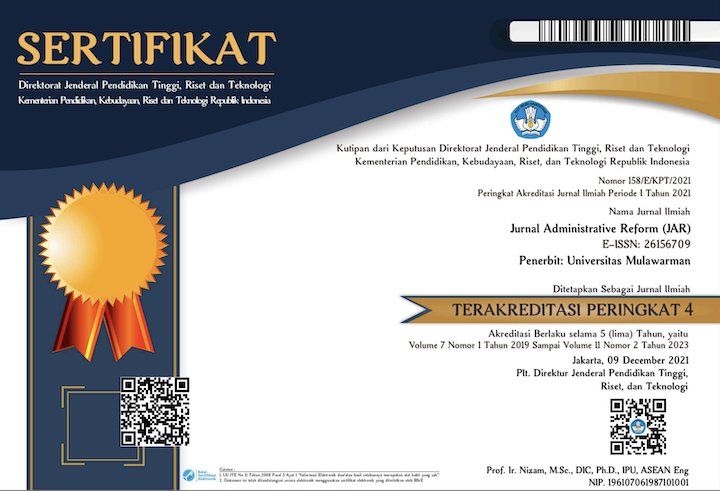ANALISIS PERTUMBUHAN ORGANISASI KEPEMUDAAN DAN IMPLIKASINYA TERHADAP KERUKUNAN ANTAR SUKU DI KOTA SAMARINDA
Abstract
This article discusses the description of the growth of tribal-based youth organizations and the dynamics of the implications of their presence on inter-ethnic harmony in Samarinda City. A qualitative approach is used as a research method. The research data were obtained from observations, interviews, literature studies and documentation which were analyzed using a qualitative data analysis model. The research findings show an increase in terms of quantity and is in the infant period and childhood phase (Go-Go). The presence of tribal-based youth organizations has real implications for the creation of inter-tribal harmony through the dynamics and behavior of youth organizations which are reflected in positive activities that support the creation of harmony such as peace ambassador activities, sirapeang, fundraising, and joint sports competitions.
Keyword: organizational growth, implications, youth, ethnicity, harmony
Full Text:
PDFReferences
Adizes, I. (1989). Corporate Lifecycles : How and Why Corporations Grow and Die and What to do About It. Prentice - Hall.
Afdol, S. (2016). Peran Pemuda Dalam Mewujudkan Kerukunan Antar Umat Beragama (Studi Kasus Di Komunitas Lintas Iman Pondok Damai Kota Semarang). IAIN Walisongo.
Creswell, J. W. (2017). Research Design: Pendekatan Kualitatif, Kuantitatif, dan Mixed (Edisi Keti). Pustaka Pelajar.
Creswell, J. W. (2018). 30 Keterampilan Esensial Untuk Penelitian Kualitatif. Pustaka Pelajar.
Davis, K. (1989). Human Resources and Personnel Management. McGraw-Hill.
Dinas Sosial Kaltim. (2014). Revisi Laporan Akhir Pemetaan Daerah Rawan Bencana Sosial di Kalimantan Timur.
Feldman, S. (2019). Cross-Cultural Leadership and Organizational Culture: a South African Perspective. Int Journal of Social Sciences Management and Enterpreneurship, 3(2), 79–94.
JPPN. (2014). 42 Titik Rawan Konflik Sosial di Indonesia. Www.Jppn.Com. https://www.jpnn.com/news/42-titik-rawan-konflik-sosial-di-indonesia
Novianty, F. (2017). Peran Organisasi Mahasiswa Ekstra Universiter Dalam Membina Kerukunan Antarumat Beragama. Jurnal Pendidikan Kewarganegaraan, 1(1).
Shihab, A. (1999). Islam Inklusif. Mizan.
Sugiyono. (2018). Metode Penelitian Kuantitatif, Kualitatif, dan R&D. Alfabeta.
Sugiyono. (2019). Metode Penelitian Kualitatif. Gramedia.
Yuniarti. (2016). Upaya Penanganan Konflik Sosial di Kalimantan Timur.
DOI: http://dx.doi.org/10.30872/jar.v10i2.7563
Refbacks
- There are currently no refbacks.
Copyright (c) 2022 Jurnal Administrative Reform

This work is licensed under a Creative Commons Attribution-NonCommercial-ShareAlike 4.0 International License.
Jurnal Administrative Reform (JAR)
pISSN: 2337-7542 | eISSN: 2615-6709
Organized and Published by Magister Administrasi Publik - Fakultas Ilmu Sosial dan Ilmu Politik, Universitas Mulawarman
W : http://e-journals.unmul.ac.id/index.php/JAR/
E : jurnal.adm.reform@unmul.ac.id

Jurnal Administrative Reform (JAR) is licensed under a Creative Commons Attribution-ShareAlike 4.0 International License.




